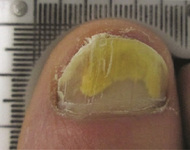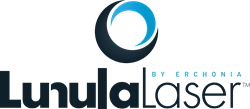FUNGAL TOENAILS
Fungus can affect the skin ("athlete's foot") and nails, causing altered appearance, sometimes symptoms and pain (from thickness and shoe pressure). With the nail, the most common form of fungal infection is under the nail, starting from the farthest (open) edge, and spreading towards the rest of the toe. There are other less common forms which occur on the surface of the nail. Fungus is a very slow growing but hardy organism, and one usually doesn't notice when this starts. So it is always difficult to know what or where to blame. It is usually not a case of poor hygiene. This also makes it a long term process to know if any treatment is working.
There are other conditions which can mimic fungal toenails, and sometimes fungal culture or nail biopsy is necessary to determine the diagnosis.
TREATMENT for FUNGAL NAILS
TOPICAL treatment is long term (at least 6 months, usually more like 12), requires a commitment to a daily regimen, and although improvement is often achieved, cure is not. The less involved the nail, the more likely the success, so this is likely to be recommended only for lesser involved nails. Periodic cutting away of the affected nail by a podiatrist is often necessary for effectiveness. Usually the only side effects, if any, are local irritation. There have been many topical treatments suggested, including essential plant oils, vinegars, disinfectants, OTC products and prescription medications. Recently (2014), there are 2 newly-FDA-approved topical prescription medications for nails. Unfortunately, they are both extremely expensive and may have high copayments even if covered under insurance. Both of them, Jublia and Kerydin, currently have a lower copayment offered by the manufacturers (discounts) under certain circumstances.
ORAL antifungal medication is available and is the most successful. One must discuss with the doctor potential side effects of any drug taken systemically, including interactions with other medications being taken and contraindications. "Pulse dosing"* is helpful in reducing potential side effects, by reducing the overal amount of medication taken. Studies show that this can be just as effective, but takes a longer time to complete.
* - Pulse dosing: taking medication on a specific schedule, with "rest" (no medication) periods in between, usually spread out over a longer period of time than standard dosing. The goal being to get the same result with taking less total medication.
LASER treatment is more recently available, though long term effectiveness is not known, since studies are lacking. However, short term improvement does occur in many cases. For best results, more than one application is necessary. The primary barrier to doing this is cost. There is no medical insurance coverage for these procedures, and, due to the cost of the technology, charges are significant. There is also some confusion caused by the industry because of claims for (different) lasers that have not presented results showing successful eradication of nail fungus or clearing of nails.
There are 2 different classes of lasers, low-level (energy) and high-level, utilizing different light wavelengths. Mechanism of action is different between the two. All of the earlier lasers are high energy, utilizing heat to eradicate the fungus. The most recent device is a unique, low-level dual wavelength laser, which uses 2 different wavelengths of laser light to create different and synergistic effects. This practice utilizes the low-energy dual laser (LunulaLaser) for treatment of fungal nails. For more information on laser treatment, click here.
COMBINATION of treatments of nails may be necessary to maximize chances of success. I.e., one can do oral, laser and topical treatment all at the same time.
LENGTH OF TREATMENT Because toenails are slow-growing, the nails must be monitored for months to determine success. Unfortunately, there is no "instant" treament. Minimum length of treatment and/or follow-up is 6 months. One likely has to monitor and wait at least 12 months to evaluate the long-term effect.
FUNGAL TOENAIL "CURE": The standard for success in treating fungal toenails is the eradication of the growth of fungus and clearing of the nail over a period of time, usually after 1 year, but this varies from study to study. As mentioned above, different methods produce varying rates of success. So far, there is nothing that produces 100% success rates. All outcomes are evaluated on the growth of the new nail growing in, which is replacing the old, affected ugly nail (which takes time to assess). Oral medication is known to be the most successful, and LASER may turn out to be as successful, although at this point, it is likely less. So, at best, any treatment is 60-80% successful, which means there is "failure" 20-40% of the time. However, failure does not mean there is not significant improvement. How long the fungus has been present and the severity of involvement directly affects success rate. In other words, the longer the nail has been infected and the closer to 100% involvement the nail is, the more difficult it is to obtain successful clearing. The most challenging cases are where 9-10 nails are completely involved. The goal for treatment is complete clearing of the toenail. See below regarding thick toenails (which may not be due to fungus).
Unfortunately, successful eradication does not mean that one is forever IMMUNE to fungus. Various regimens and strategies are suggested to try to reduce the likelihood, but potential subsequent reinfection is a reality of the situation, and treatment may be needed again in the future.
THICK TOENAILS
Thick toenails can arise from fungal infection, trauma (injury), or other nail diseases.
Fungal infection often causes the toenail to thicken. When this has been long standing and the infection goes back to the base of the nail (where the nail grows from), there is some chance of permanent change in the shape of the nail. This means that even with eradication of the fungus, there may be some permanent thickening of the nail. The nail could be clear of fungus, but still grow out thick or misshapen. There is no predicting this, no matter the treatment method. What is sometimes confusing is when the nail is injured and grows out thick and deformed, which then makes it more susceptible to fungal infection, which then, if it occurs, looks like a "fungal toenail". In this case, eradicating the fungus will not change the misshapen nail, which is permanent. But it will look clearer.
If the cause of thickening is not fungus, then antifungal treatment will not change this. To determine fungus a skin scraping is sent to a lab for testing and/or viewing of a nail tissue under the microscope. Nail biopsy is used to identifiy other nail pathologies/diseases.


